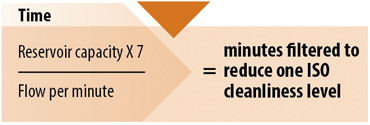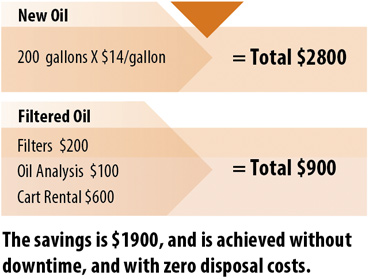|
1.800.404.2570 Home | Metalworking Lubricants | Heavy Duty Truck Lubes | Industrial Lubricants | |
 |
 |
| Acculube Oil Filtration Systems |
Custom Packaging | Buying Power | Product Selection |
Oil Filtration Systems
This is the portable, cost-effective, operator-friendly solution to the demand for contaminant-free fluids, and (nearly) maintenance-free filtration. Why Effective Filtration is Needed Oil has 4 functions in manufacturing:
How Acculube's Oil Filtration Systems Work The innovative flow-through filtration system supplied and serviced by Acculube was engineered specifically for manufacturing fluids. It is a multi-element filter that forms a positive barrier to channeling. The flow of oil carries contaminants deep into the media. Oil is routed from the top and bottom of the filter element, through the media, to the collector, to the center tube, and out the canister. As oil moves through the media, pressure is reduced, while the exterior pressure of the element remains constant. Larger particles are captured at the top and smaller particles are retained in the lower portion of the filter. Oil flow travels through the layers of the elements and into the oil return tube of This highly efficient oil filtration technology enables the filter to retain a large volume of contaminants without blinding, and without compromise of filter performance. It is a superior alternative to conventional surface media filters. What Particles are Filtered? The eye can see particulate down to about 40 microns. (For reference, a human hair is 35-40 microns.) In today's machinery, lubricant film can be as thin as a few microns. If you can see particles in your oil, there's a serious problem that needs immediate attention. The particles we are describing are destructive wear particles that are not visible without magnification. What's the Impact? To do its job, oil must be free from debris. The universal cleanliness standard, ISO 4406c, is detailed on the chart at right. It shows Upgrading from ISO cleanliness code 22/21/18 to ISO Cleanliness Code 16/14/11 can extend the life of a variable displacement How It Works Acculube Filtration Systems filter new lubricant as it's put into service. It also conditions lubricants that are in use, and when transferring lubricants from tanks to reservoirs. The Needs of Hydraulic Systems Contamination is introduced each time a ram extends and retracts. Airborne particulate can also land on the cylinder and be The Quest for Perfect Filtration In a perfect world, one filter would deliver 10 things. It would:
Acculube's Oil Filtration Systems accomplish all of these goals. It is "lean thinking" applied to a critical maintenance task - and a proven alternative to the cost of buying, inventorying, installing, replacing, and managing fluid filters. 6 Simple Steps
|
Major Brands: |
|
|
|
|
|
|
Accurate Lubricants & Metalworking Fluids, Inc.• 403 Homestead Avenue; Dayton, Ohio 45417 USA • Phone: 937-461-9906 Fax: 937-461-9917 © 2017 by Accurate Lubricants & Metalworking Fluids, Inc. located in Dayton, Ohio U.S. All rights reserved. We are a fluids supplier to American manufacturers and service providers in a geographic area that includes Ohio (Toledo, Columbus, Dayton, Springfield, Cincinnati), Indiana (Indianapolis, Fort Wayne, Columbus, Richmond, Kokomo, Muncie, South Bend, Lafayette, Elkhart), and Northern Kentucky. Accurate Lubricants & Metalworking Fluids, Inc. and Acculube are separate and distinct from Accu-Lube, a lubricant manufactured by ITW Rocol. |



